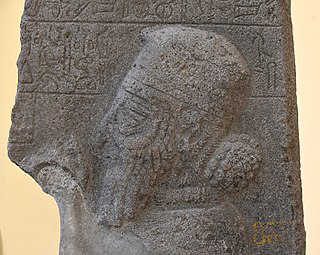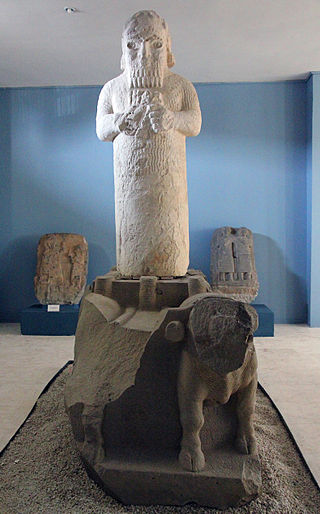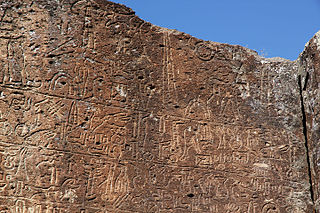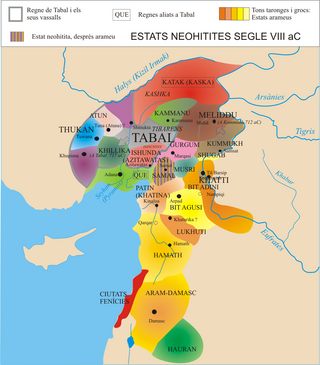Tunna or Dunna was an ancient Anatolian city located at the foothills of the Taurus Mountains, near the town of Ulukışla and the Cilician Gates in southern Cappadocia.

Carchemish, also spelled Karkemish, was an important ancient capital in the northern part of the region of Syria. At times during its history the city was independent, but it was also part of the Mitanni, Hittite and Neo-Assyrian Empires. Today it is on the frontier between Turkey and Syria.

Tabal, later reorganised into Bīt-Burutaš or Bīt-Paruta, was a Luwian-speaking Syro-Hittite state which existed in southeastern Anatolia in the Iron Age.

Tyana, earlier known as Tuwana during the Iron Age, and Tūwanuwa during the Bronze Age, was an ancient city in the Anatolian region of Cappadocia, in modern Kemerhisar, Niğde Province, Central Anatolia, Turkey.

The states called Neo-Hittite, Syro-Hittite, or Luwian-Aramean were Luwian and Aramean regional polities of the Iron Age, situated in southeastern parts of modern Turkey and northwestern parts of modern Syria, known in ancient times as lands of Hatti and Aram. They arose following the collapse of the Hittite New Kingdom in the 12th century BCE, and lasted until they were subdued by the Assyrian Empire in the 8th century BCE. They are grouped together by scholars, on the basis of several cultural criteria, that are recognized as similar and mutually shared between both societies, northern (Luwian) and southern (Aramaean). Cultural exchange between those societies is seen as a specific regional phenomenon, particularly in light of significant linguistic distinctions between the two main regional languages, with Luwian belonging to the Anatolian group of Indo-European languages and Aramaic belonging to the Northwest Semitic group of Semitic languages. Several questions related to the regional grouping of Luwian and Aramaean states are viewed differently among scholars, including some views that are critical towards such grouping in general.

Warpalawas II was a Luwian king of the Syro-Hittite kingdom of Tuwana in the region of Tabal who reigned during the late 8th century BC, from around c. 740 to c. 705 BC.
Cybistra or Kybistra, earlier known as Ḫubišna, was a town of ancient Cappadocia or Cilicia.
The Luwians were an ancient people in Anatolia who spoke the Luwian language. During the Bronze Age, Luwians formed part of the population of the Hittite Empire and adjoining states such as Kizzuwatna. During the Hittite New Kingdom, Luwian replaced Hittite as the empire's dominant language. In the early Iron Age, a number of Luwian-speaking Neo-Hittite states arose in northern Syria. The Luwians are known largely from their language, and it is unclear to what extent they formed a unified cultural or political group.
Sangara or Sangar was a king of Carchemish. He belonged to the House of Suhi of Carchemish, and ruled from 870 to 848 BC.

The Çineköy inscription is an ancient bilingual inscription, written in Hieroglyphic Luwian and Phoenician languages. The inscription is dated to the second half of the 8th century BC. It was uncovered in 1997 near the village of Çine, that is located some 30 km south of Adana, capital city of the Adana Province in southern Turkey.
Kuzi-Teshub was a Neo-Hittite King of Carchemish, reigning in the early to mid-12th century BC, likely in 1180-1150 BC. He was the son of Talmi-Teshub, who was both the last viceroy of the Hittite Empire at Carchemish under Suppiluliuma II and a direct descendant of Suppiluliuma I. Kuzi-Teshub reigned in Carchemish as well as in the later Neo-Hittite city of Melid.

Palistin, was an early Syro-Hittite kingdom located in what is now northwestern Syria and the southeastern Turkish province of Hatay. Its existence was confirmed by the discovery of several inscriptions mentioning Taita, king of Palistin.
The House of Astiruwa was the last known dynasty of rulers of Carchemish. The members of this dynasty are best known to us through Hieroglyphic Luwian sources. One member of the House of Astiruwa may also be referred to in Assyrian sources.
The House of Suhi was a dynasty of rulers of Carchemish. The members of this dynasty are best known to us through Hieroglyphic Luwian sources. Only one member of the house of Suhi is specifically mentioned in Assyrian sources. The House of Suhi was followed by a dynasty known as the House of Astiruwa.

Ḫartapus or Kartapus was an Anatolian king who in the early 8th century BCE ruled a state in what is presently the region of Konya in modern Turkey.

Hittite art was produced by the Hittite civilization in ancient Anatolia, in modern-day Turkey, and also stretching into Syria during the second millennium BCE from the nineteenth century up until the twelfth century BCE. This period falls under the Anatolian Bronze Age. It is characterized by a long tradition of canonized images and motifs rearranged, while still being recognizable, by artists to convey meaning to a largely illiterate population.
“Owing to the limited vocabulary of figural types [and motifs], invention for the Hittite artist usually was a matter of combining and manipulating the units to form more complex compositions"

Wasusarmas was a Luwian king of the Syro-Hittite kingdom of Tabal proper in the broader Tabalian region who reigned during the mid-8th century BC, from around c. 740 BC to c. 730 BC.

Atuna or Tuna was a Luwian-speaking Syro-Hittite state which existed in the region of Tabal in southeastern Anatolia in the Iron Age.

Šinuḫtu was a Luwian-speaking Syro-Hittite state which existed in the region of Tabal in southeastern Anatolia in the Iron Age.









